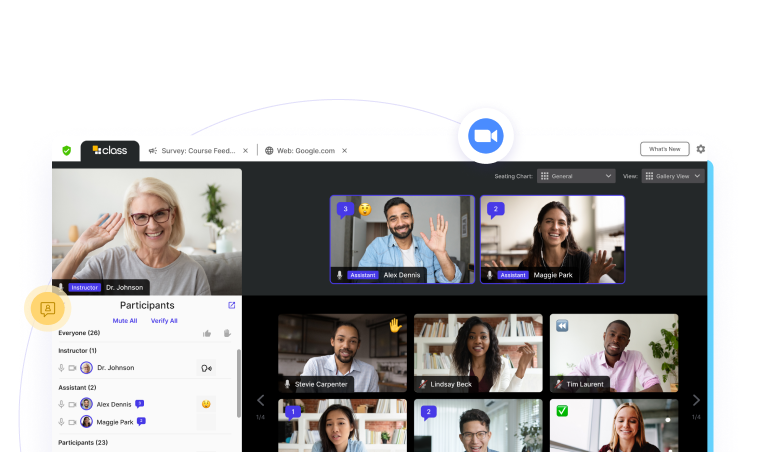
Mike Lovell is the SVP of Marketing at Class. He has dedicated his career to technology and the applications that can innovate the way people live and learn.

Mike Lovell is the SVP of Marketing at Class. He has dedicated his career to technology and the applications that can innovate the way people live and learn.

As virtual classroom offerings become more popular among learners—a recent Rand study found 1 in 5 K-12 schools intend to provide online-only options—many school districts and institutions find themselves debating about synchronous vs. asynchronous education, hybrid learning styles, and the various modalities available with teaching online.
Gone are the days when virtual classroom platforms were essentially web conferencing for education. Now, online classroom platforms are far more robust and provide educators and learners with numerous ways to deepen the academic experience, as well as provide true accessibility for more learners. As Ellen Li, a co-founder of Princeton’s Disability Collective, tells the Chronicle of Higher Education, “Providing no online option is equivalent to denying disabled students, and teachers, any place in [schools].” With advancing technologies, the pros and cons of synchronous, asynchronous, and hybrid learning for online classrooms are becoming more well-defined.
Synchronous online learning mainly categorizes the nature by which instructors and learners interact—keeping those communications occurring in real time. Much like in-classroom settings, synchronous online learning can occur either lecture-style (one-way) or interpersonally (two-way) at a specified time where all participants are present virtually.
A clear benefit of synchronous online learning is the ability for learners to have input into the information being dispersed. This can be via questions, clarifications, group discussions, and more. The nature of synchronous online learning has evolved, as well. Virtual classroom platforms now provide enhanced features like breakout rooms, self-paced video viewing, and much more that allow students to be present, engage in real-time, and retain a degree of learning autonomy.
Additionally, as Matt Marino points out in his editorial for Education Articles, synchronous online learning provides structure and routine for students, which can also benefit their comprehension success. This routine can also benefit educators who are teaching online using modified versions of previous lesson plans.
While communicating in real-time has obvious advantages for educators and learners, there are some drawbacks. Much like a brick-and-mortar classroom, synchronous online learning can only happen at predetermined times, so if there is any sort of scheduling conflict, that learning opportunity is missed.
Additionally, if relying solely on real-time communication without asynchronous resources like study sheets and recordings, students may fall behind and miss pieces of information or struggle to take notes and participate fully. Much like in-classroom settings, learners who are shy may also have difficulty providing feedback, whether in the form of questions for clarification or requesting an instructor repeat themselves or slow down.
Asynchronous online learning, by comparison, occurs in staggered timelines. An instructor may post a lecture or a reading assignment first thing in the morning and students may have a predetermined amount of time (for instance, 24 hours) to engage with the piece at a time that works best in their schedule.
A notable advantage of asynchronous online learning is the flexibility it allows both educators and learners. In the debate of synchronous vs. asynchronous online learning, students with nontraditional schedules (like youth who are performers or athletes), as well as nontraditional higher education students who have full-time jobs, family responsibilities, and other commitments can benefit greatly from this flexible scheduling.
Another valuable reason asynchronous online learning is so popular is that it eliminates the barrier of time zones. As eLearning Industry explains, “Learners are no longer limited to options available in their region and country, but can enroll in a course from a [school] in another part of the world with just a few clicks.” While virtual classrooms theoretically remove the need for physical proximity, a student on a different continent would struggle to consistently attend a synchronous course which requires them to be up in the middle of the night. Asynchronous online learning allows anyone, anywhere to participate.
While flexibility is a very enticing feature, strictly asynchronous online learning can reduce a learner’s ability to engage, build peer relationships, and work collaboratively. Group projects are still largely solo endeavors in a strictly asynchronous workspace, further discussion of course topics is stunted and takes longer to evolve due to large gaps between various users’ input.
Additionally, pre-recorded lectures or pre-defined assignments don’t allow for students to ask questions or get clarifications in real-time so learners are left to await additional asynchronous communication—via email, LMS messaging, texting, etc.—before starting on their assignment.
While the debate still rages on for some educators on the value of synchronous vs. asynchronous online learning, many have realized that hybrid learning styles allow them to leverage the benefits of each to the advantage of the educator and learners. Hybrid learning in a virtual classroom entails a structured online course that incorporates both real-time and at-your-own-pace educational experiences.
Synchronous and asynchronous online learning have many advantages, as noted above. Hybrid learning in a virtual classroom taps into the power of both modalities. Some assignments, quizzes, lectures, and more are available for at-your-own-pace consumption and participation; however, there are structured synchronous experiences where the instructor and learners come together virtually in real-time for lecture or coursework, to engage in breakout rooms and collaborative work, and even for virtual instructor office hours.
Johnson, et al (2022) add, “Enabling learners to feel connected both to course content and to a community of learners within the course is another key aspect of an evidence-based approach to K–12 online instruction.” This holds true in higher education, as well.
As online classroom platforms have transformed the way learners and educators engage virtually, so has the evolution of removing the limitation of teaching modalities. School districts and institutions that offer the flexibility of asynchronous online learning opportunities for certain assignments and coursework alongside the valuable real-time engagement and interaction of synchronous instructor-student communication stand to benefit tremendously. By empowering educators and learners, hybrid learning approaches within virtual classrooms put school districts and institutions at the forefront of education.
Curious to discover how synchronous and asynchronous learning hybrids can enhance your school district or institution’s academic offerings? Reach out to a Class team member today, and let’s take your online learning experience to the next level.

Mike Lovell is the SVP of Marketing at Class. He has dedicated his career to technology and the applications that can innovate the way people live and learn.

Mike Lovell is the SVP of Marketing at Class. He has dedicated his career to technology and the applications that can innovate the way people live and learn.
Get our insights, tips, and best practices delivered to your inbox

Sign up for a product demo today to learn how Class’s virtual classroom powers digital transformation at your organization.

Features
Products
Integrations